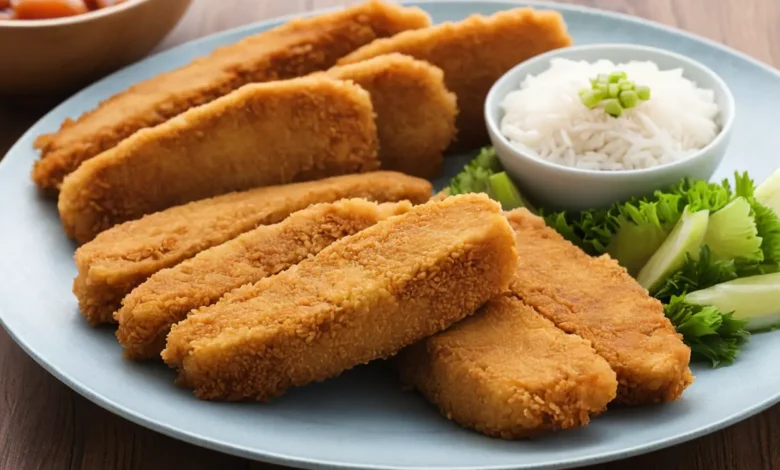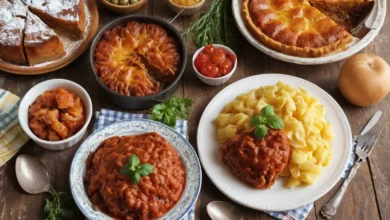All About Katsu: Your Guide to Japan’s Crispy, Flavorful Fried Cutlets

Katsu, a beloved staple in Japanese cuisine, is a breaded and fried cutlet that offers a satisfying crunch and juicy flavor. Whether it’s made from chicken, pork, or seafood, katsu has captivated food lovers around the world. This dish is celebrated for its simplicity, versatility, and delightful contrast of textures. In this guide, we’ll dive into everything you need to know about katsu—from its origins and types to easy recipes and common questions, making it easy for you to enjoy authentic katsu at home.
What is Katsu?
Katsu, which comes from the English word “cutlet,” typically refers to breaded and fried meat cutlets. It’s known for its crunchy coating, made from panko (Japanese breadcrumbs), which keeps the meat tender and juicy. Katsu is served with shredded cabbage, a side of rice, and a dipping sauce, often a tangy katsu sauce. The most popular types of katsu are Tonkatsu (pork cutlet) and Chicken Katsu, though seafood versions like Ebi Katsu (shrimp cutlet) are also widely enjoyed.
The Key Ingredients for a Perfect Katsu
Katsu is made with minimal ingredients, but each one plays an important role in creating its signature taste and texture.
- Panko Breadcrumbs: Unlike regular breadcrumbs, panko is light and flaky, making the katsu coating crispier and less oily. This helps the cutlet achieve its characteristic golden brown color.
- Meat: Pork loin and chicken breast are common choices. Pork is typically used for Tonkatsu, while chicken is preferred for Chicken Katsu.
- Katsu Sauce: This tangy, slightly sweet sauce is a blend of Worcestershire sauce, soy sauce, and other spices, bringing out the flavors of the fried cutlet.
- Cabbage: Served as a side, shredded cabbage adds a refreshing crunch that balances the rich flavor of katsu.
- Rice: A traditional katsu meal often includes steamed rice, completing the dish with a soft, mild base that complements the bold flavors of the katsu.
How to Make Authentic Katsu at Home
Making katsu at home is easy and only requires a few simple steps.
Recipe for Homemade Katsu
- Ingredients:
- 2 boneless pork chops or chicken breasts, pounded to ½ inch thickness
- Salt and pepper to taste
- ½ cup all-purpose flour
- 2 large eggs, beaten
- 1 cup panko breadcrumbs
- Oil for frying
- Katsu sauce for serving
- Instructions:
- Prepare the Meat: Season the meat with salt and pepper, then pound it to an even thickness to ensure even cooking.
- Set Up the Coating: Place flour, beaten eggs, and panko breadcrumbs in three separate bowls. First, coat each piece of meat in flour, then dip it in the egg, and finally coat it thoroughly with panko breadcrumbs.
- Fry the Katsu: Heat oil in a skillet to around 350°F (175°C). Fry each piece for 3–4 minutes on each side until it’s golden brown and crispy. Transfer to paper towels to drain any excess oil.
- Serve: Slice the katsu into strips, serve with a side of shredded cabbage, steamed rice, and katsu sauce.
Popular Types of Katsu
The versatility of katsu has led to several delicious variations. Here are some popular types:
- Tonkatsu (Pork Katsu)
Tonkatsu is one of the most popular katsu varieties, typically made from pork loin or tenderloin. Its hearty flavor pairs well with tangy katsu sauce, making it a Japanese comfort food favorite. - Chicken Katsu
Chicken Katsu is a lighter alternative to Tonkatsu and is loved for its tender, juicy texture. It’s a go-to option for bento boxes, sandwiches, or standalone meals served with rice and cabbage. - Gyukatsu (Beef Katsu)
Gyukatsu is a unique twist on traditional katsu, featuring a beef cutlet instead of pork or chicken. Often cooked medium-rare, Gyukatsu is popular for its rich flavor and is sometimes served with a side of horseradish or wasabi. - Ebi Katsu (Shrimp Katsu)
For seafood lovers, Ebi Katsu is a great choice. Made from breaded shrimp, this version offers a lighter, yet equally satisfying, taste that’s especially popular in Japanese-American fusion cuisine. - Katsu Sando (Katsu Sandwich)
Katsu Sando is a Japanese sandwich that layers katsu between slices of soft, crustless bread. Commonly enjoyed as a convenient snack or lunch, it’s often paired with cabbage and katsu sauce for extra flavor.
Why Katsu Sauce is a Must-Have
Katsu sauce is integral to the katsu experience, adding a tangy, savory kick that enhances the flavor of the breaded cutlet. Made from a combination of Worcestershire sauce, soy sauce, sugar, and various seasonings, it’s the perfect complement to katsu’s crunchy texture. If you’re unable to find it at the store, you can easily make a quick substitute by mixing equal parts Worcestershire sauce, ketchup, and a dash of soy sauce.
Frequently Asked Questions About Katsu
- Is katsu healthy?
Katsu is fried, so it’s calorie-dense. However, pairing it with fresh cabbage and rice can add nutritional balance. Baking the cutlet is another way to enjoy a lighter version. - Can katsu be baked instead of fried?
Yes, katsu can be baked! Place breaded cutlets on a baking sheet, spray lightly with oil, and bake at 400°F (200°C) for 20–25 minutes, flipping halfway through. - What’s the difference between katsu and tempura?
While both are fried, katsu uses panko breadcrumbs for a crunchier texture, whereas tempura uses a light batter, resulting in a lighter, crispier coating. - How is Gyukatsu different from Tonkatsu?
Gyukatsu is made with beef, often cooked medium-rare, while Tonkatsu is made with pork and cooked well-done. Gyukatsu is usually served with horseradish or soy sauce. - How can I store leftover katsu?
Leftover katsu can be refrigerated for up to two days. To reheat, use an oven or toaster oven to maintain its crispiness, as microwaving may make it soggy.
Cultural Significance of Katsu in Japan
Katsu has become an iconic part of Japanese cuisine and is widely enjoyed across the country. Many believe that katsu brings good luck, as it sounds similar to the Japanese word “katsu,” meaning “to win.” As a result, students, athletes, and professionals often eat katsu before exams, competitions, or important events for an extra boost of confidence.
Conclusion
Whether you prefer Tonkatsu, Chicken Katsu, or the unique Gyukatsu, katsu is a dish that brings together flavor, texture, and cultural significance. With its crispy panko coating, tender meat, and bold katsu sauce, katsu is a meal that offers comfort and satisfaction in every bite. Try making it at home with the easy recipe above, and enjoy a taste of Japan right in your kitchen.





